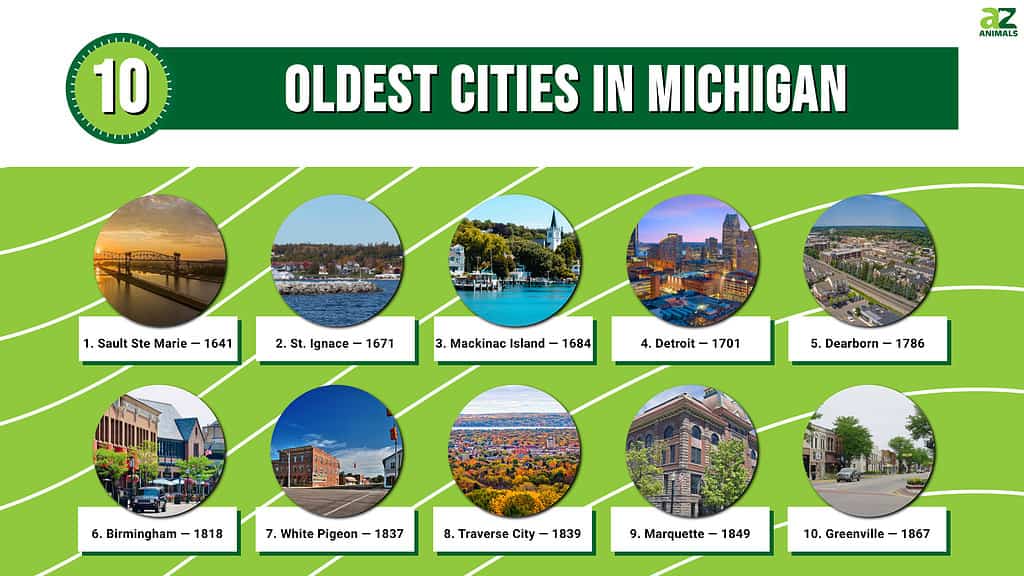
With the unpredictable weather in Michigan, it’s hard to see why the settlers exploring the “New World” would want to lay down roots there. However, in the 17th century, French explorers saw massive potential in the mitten-shaped state, which resulted in fur traders and missionaries following suit.
Eventually, they started intermingling with some of the natives who occupied the land, and soon cities began forming all over the state. However, the oldest cities in Michigan seem to be located in the Upper Peninsula. So with that said, here are the ten oldest cities in Michigan.
Eight Oldest Cities in Michigan
1. Sault Ste Marie — 1641
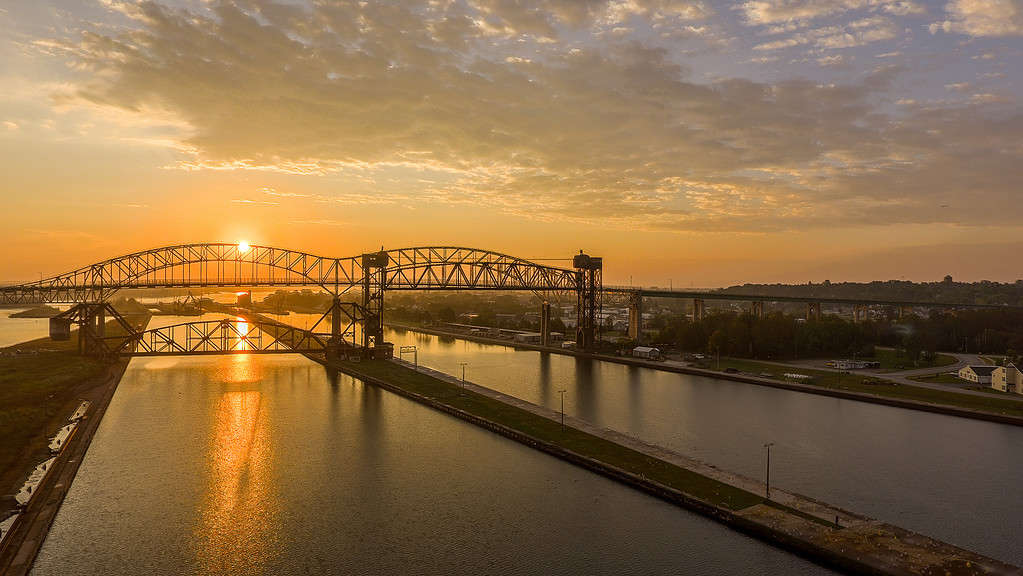
The Sault Ste Marie has been inhabited since 2000 B.C.
©jscottsmith/Shutterstock.com
Archaeological evidence shows humans have resided in the Sault Ste Marie area since 2000 B.C. Tribes like the Ojibwe call this place Bahweting, meaning the gathering place. However, a formal settlement was only established in 1668 by several Jesuit priests, including Jacques Marquette, who lived in the area, and St. Jogues, who arrived in Sault Ste Marie in 1641.
There are actually two Sault Ste Maries, one in Michigan and one just across St. Marys in Ontario, Canada. Furthermore, these two cities are often referred to as the twin Saults. However, when the first settlers arrived, the river did not divide these twin cities. In fact, it didn’t even separate the two countries. People only viewed it as a river with natives fishing on each side.
But, after the war in 1812, an international boundary was formed between the two cities, and Sault Ste Marie, Michigan, had the bigger community. During the 20th century, the Michigan city had grown three times larger than the Ontario side. However, today Sault Ste Marie, Ontario, has a population of roughly 73,000 people, while the other twin city only has a population of approximately 14,000.
2. St. Ignace — 1671

St. Ignace, Michigan is named for French Jesuit Jacques Marquette who established the city in 1671.
©Roberto Galan/Shutterstock.com
The quant city of St. Ignace is the second oldest city in Michigan, as it was established in 1671 by French Jesuit Jacques Marquette. This explorer started a mission here and named it after the founder of the Jesuits, St. Ignatius of Loyola.
Eventually, fishermen and fur traders began to arrive, and in 1881 a rail-ferry service was established across the straits. Soon lumbering and iron-smelting industries started to form, but they didn’t last long because these industries started to decline at the turn of the 20th century. Today, the city relies on fisheries, summer tourist season, winter recreation, and dairying.
3. Mackinac Island — 1684
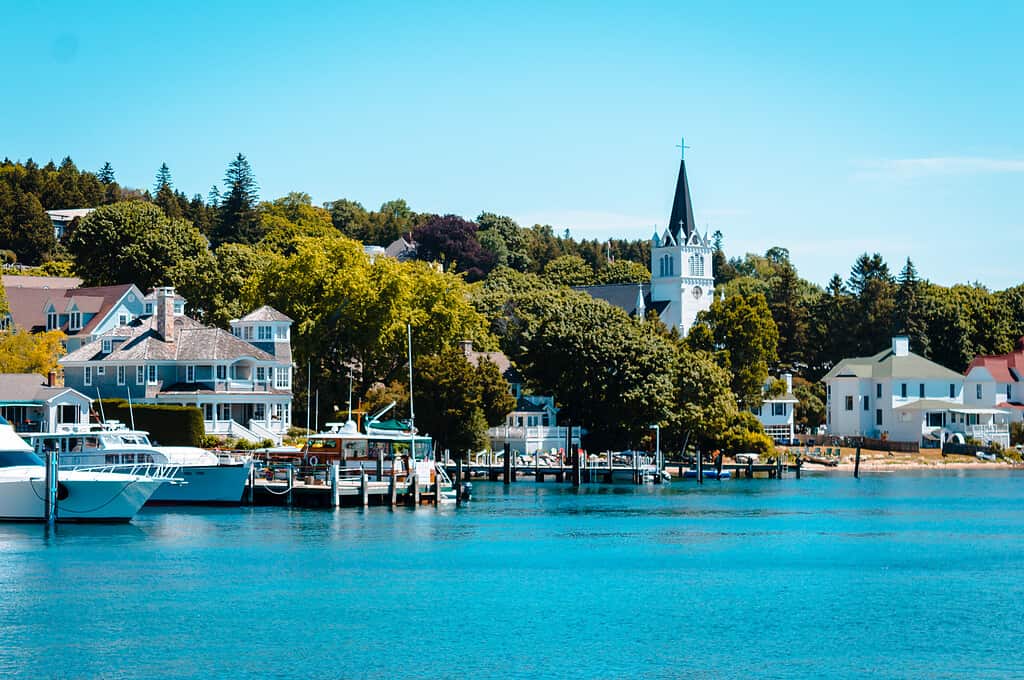
Mackinac Island was used as a sacred burial ground by Native Americans.
©Michael Deemer/Shutterstock.com
Native Americans first called Mackinac Island home long before the European settlers arrived. As a result, the Anishinaabek people have considered this island a sacred place for many years. Additionally, the island served as a sacred burial ground and an excellent area for trapping, fishing, gathering, and conquering the northern waterways.
When the Pilgrims first arrived in 1620, French explorers were traveling west toward the upper Great Lakes, also referred to as New France at the time. Fourteen years later, Europeans arrived in the area, and a Catholic mission was established 50 years later. In fact, a reconstructed Missionary Bark Chapel on the island honors the mission. This chapel is situated in Marquette Park, which is one of the best places to have a picnic in the entire state.
Today, tourists can take a horse-drawn carriage through the streets of Mackinac Island, as natives did in 1920. The city also boasts B&Bs, cottages, and hotels that have been operating since 1852. Additionally, visitors can tour the Mackinac Island Native American Museum, where they can experience what domestic life was like on the island during the fur trade era. Furthermore, daredevils can fire a cannon at Fort Mackinac, while others can admire the beauty of Mackinac Island State Park.
4. Detroit — 1701
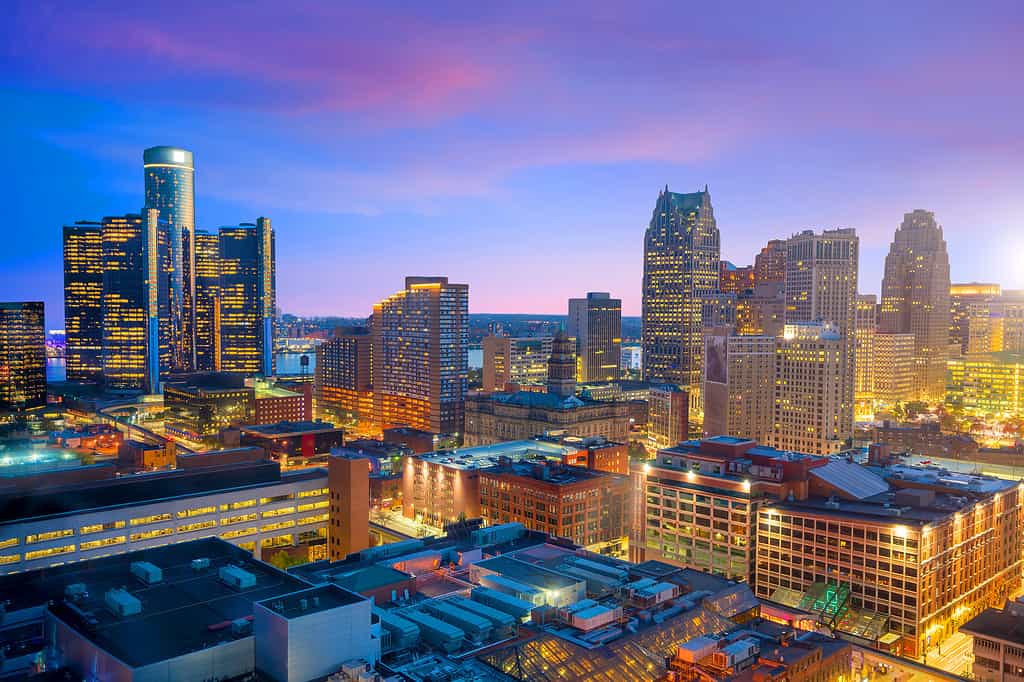
The British captured Detroit in 1812 during the Seven Years War.
©f11photo/Shutterstock.com
Detroit initially started as a fort for the French. Antoine de la Mothe Cadillac led the construction with 100 workers and soldiers and built this impressive stronghold on the Detriot River in 1701. And in 1760, a small town began to develop. However, the British captured Detriot in 1812, during the Seven Year War. But their reign didn’t last long, and in 1813, the United States Army recaptured the city.
After the war, Detroit began to develop quickly due to the harbor and steamships importing and exporting products. Additionally, the Erie Canal opened in 1825, making it easier to transport goods. Therefore, Detroit’s manufacturing industries expanded, and soon they were making buggies, wagons, steam engines, and ships. The Union admitted Michigan in 1837, and the state constitution made slavery illegal. That’s when Detroit became an essential part of the underground railroad, which served as an escape for slaves from the Southern states.
First, Pharmaceuticals became one of the major industries in Detriot, but soon the city would be known for making engines, furnaces, stoves, and railroad cars. However, the 20th century brought a new industry to this city, car manufacturing. After Henry Ford designed the first Model T in 1908, the auto business in Detroit exploded.
Due to the city’s notoriety for its automobile industry, Detroit was nicknamed Motown (motor town), and in the 1960s-1970s, a record label with the same name flourished. Their style of rhythm and blues music took over the industry, and they signed many famous artists like:
- Stevie Wonder
- The Four Tops
- The Temptations
- Lionel Richie
- Michael Jackson & the Jackson 5
- Martha Reeves and the Vandellas
- Diana Ross & the Supremes
- The Marvelettes
- Marvin Gaye
- Smokey Robinson & the Miracles
- Gladys Knight & the Pips
- The Commodores
5. Dearborn — 1786
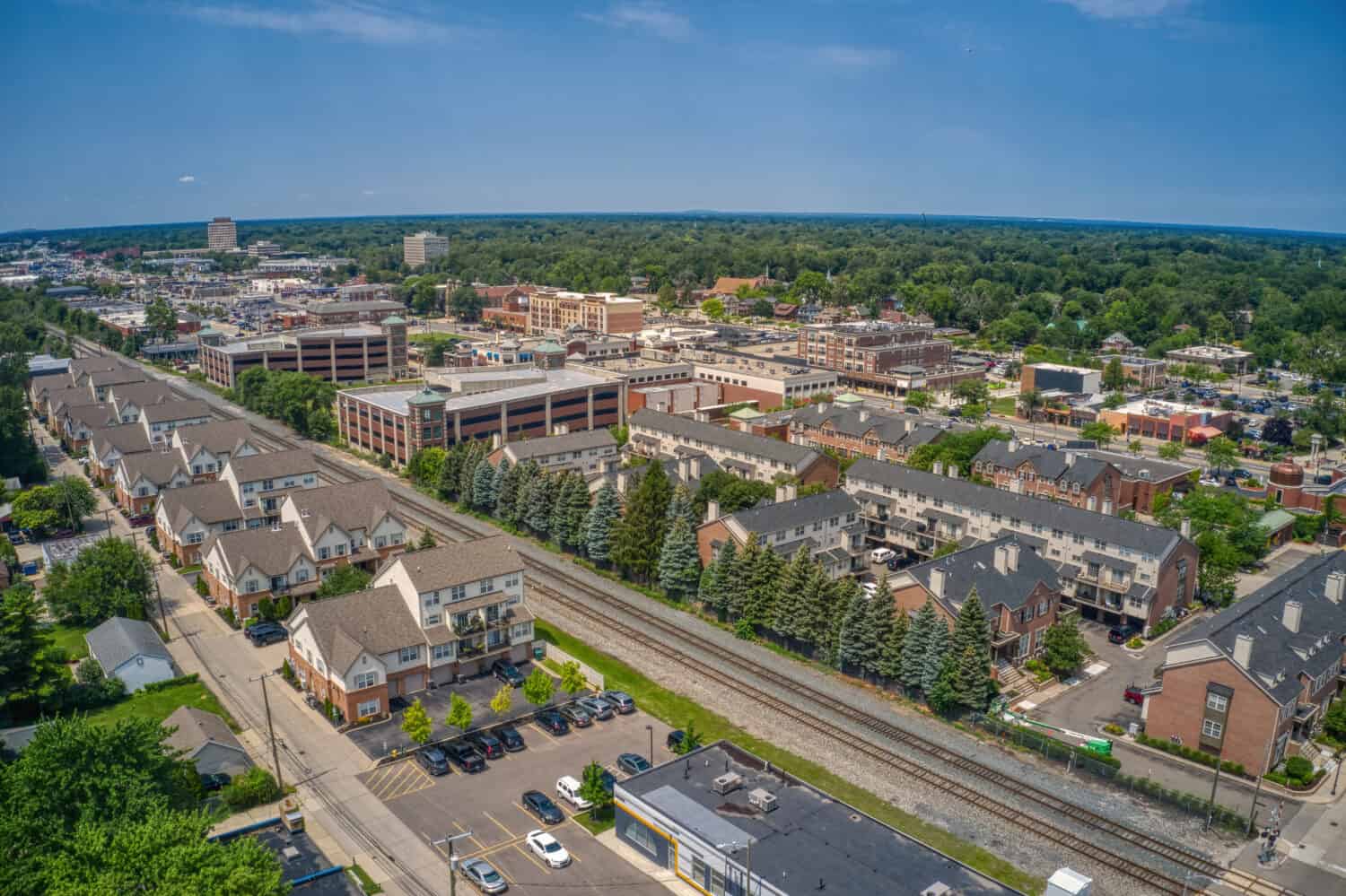
Dearborn is notorious for being the birthplace of Henry Ford, as he was born on a family farm just outside the city.
©Jacob Boomsma/Shutterstock.com
Dearborn was founded in 1789 but was only officially incorporated as a city in 1929. Today, it is the eighth largest city in Michigan and the second-largest in Wayne County. Dearborn is notorious for being the birthplace of Henry Ford, as he was born on a family farm just outside the city. As a result, the city is home to the headquarters of the Ford Motor Company, and today it is an industrial center for steel processing.
Dearborn has become a regional center for healthcare services, employment, higher education, transportation, and shopping. In addition, it has exciting environmental and cultural tourist attractions.
6. Birmingham — 1818
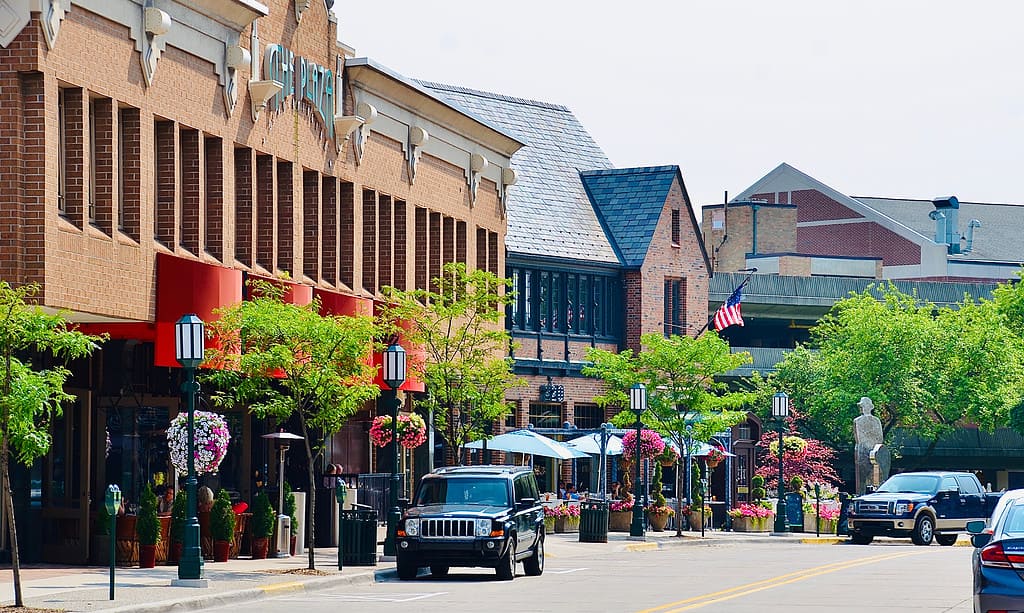
Birmingham, Michigan became a settlement in 1818.
©PQK/Shutterstock.com
Birmingham, Michigan, officially became a formal settlement in 1818, when three entrepreneurs purchased a large amount of land at the crossing of the Saginaw Trail and Rouge River, now Woodward Avenue. Together these men bought 480 acres of land and moved their families to this wilderness to start fresh. They had a vision for new business opportunities and didn’t want to focus on farming. Therefore, they encouraged businesses like broom and brick-making factories, blacksmith shops, tanneries, and transportation services.
Birmingham was named after its counterpart in England, one of the leading manufacturing cities in Great Britain at the time and the largest industrial center. However, their vision for this small settlement was short-lived, as most of the manufacturing companies abandoned this Michigan town by the 1860s. After that, however, the settlement of Birmingham became an agricultural and commercial hub. Soon, merchants, doctors, dentists, newspapers, shop owners, and lawyers put down roots in the quant town and established successful businesses. These businesses continued to offer employment and commercial opportunities for its residents into the 20th century, as farms were divided into subdivisions, and Detroit’s booming motor industry made Birmingham a desirable place to live.
Birmingham finally made the transition from quant town to city in 1933 after more than a decade of preparation. However, the city still maintains the small-town charm of years gone by throughout its residential areas and business district.
7. White Pigeon — 1837
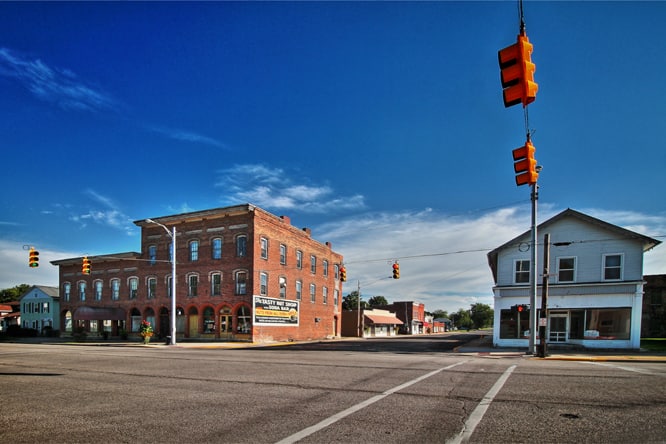
White Pigeon, Michigan was established as a town in 1837.
©Geo murphy / CC BY-SA 4.0 – License
The village of White Pigeon was first established in 1837 and named after Potawatomi Indian Chief Wahbememe, which means “White Pigeon.” There is a legend about his death; when Chief Wahbememe was at a gathering in Detroit, he heard there was an attack planned on the settlement, and as he was friends with the settlers, he ran all the way back to warn them. But, after running for almost 150 miles, he collapsed from exhaustion and died. You can find his remains buried in White Pigeon. Furthermore, his grave forms part of the Nation Register of Historic Places.
8. Traverse City — 1839
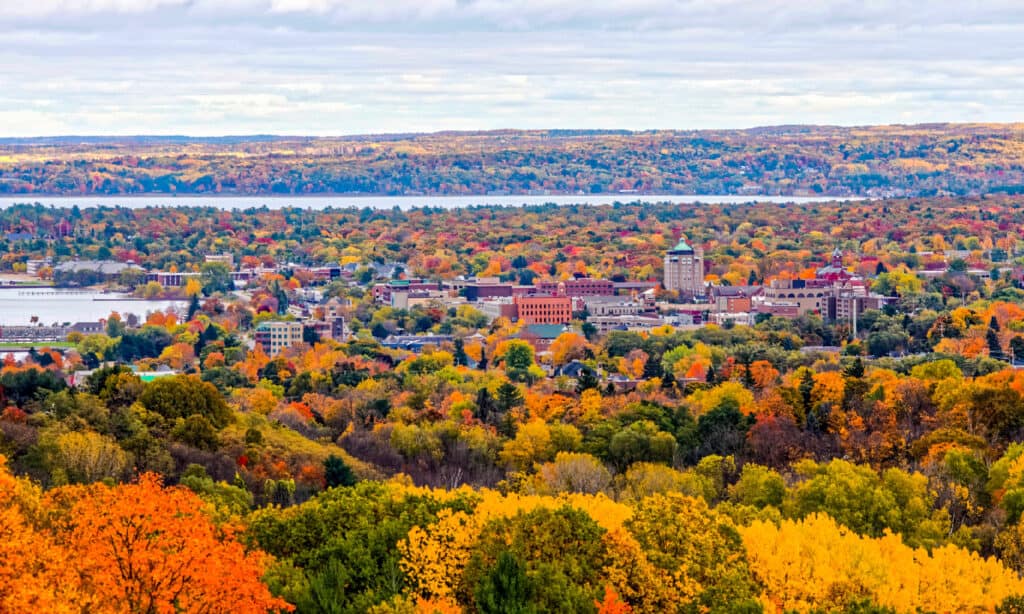
In 2009 this friendly little community was voted the best small town for tourists to visit in the USA, and in 2010 a consensus revealed there were approximately 15,000 individuals residing in Traverse City.
©iStock.com/garyrennis
This city is situated in Grand Traverse County in Michigan. It was named after Traverse Bay, named by French settlers because they traversed the lands on their travels in the 18th century. Reverend Peter Doughtery founded the Old Mission Peninsula in 1839, which was the first settlement in the area. Then, in 1847, Captain Boardman from Illinois purchased land on the Boardman River to build a sawmill, which helped the colony expand.
But, Captain Boardman sold the sawmill in 1851 to Hannah, Lay &Co, and they decided to expand the operation, which led to hundreds of people looking for work to flock to the area, and the community grew significantly. Finally, the railroad arrived in 1872, and the settlement continued to grow as the railways connected Grand Rapids and Indiana railroad. This was an excellent opportunity to expand the industries in the city and led to mass employment.
In 2009 this friendly little community was voted the best small town for tourists to visit in the USA, and in 2010 a consensus revealed there were approximately 15,000 individuals residing in Traverse City. Additionally, it is notorious as a prominent tart cherry producer, which attracts thousands of tourists each year for festivals and cherry tastings. In fact, this city has a Cherry Festival each year that attracts around 500,000 visitors.
9. Marquette — 1849
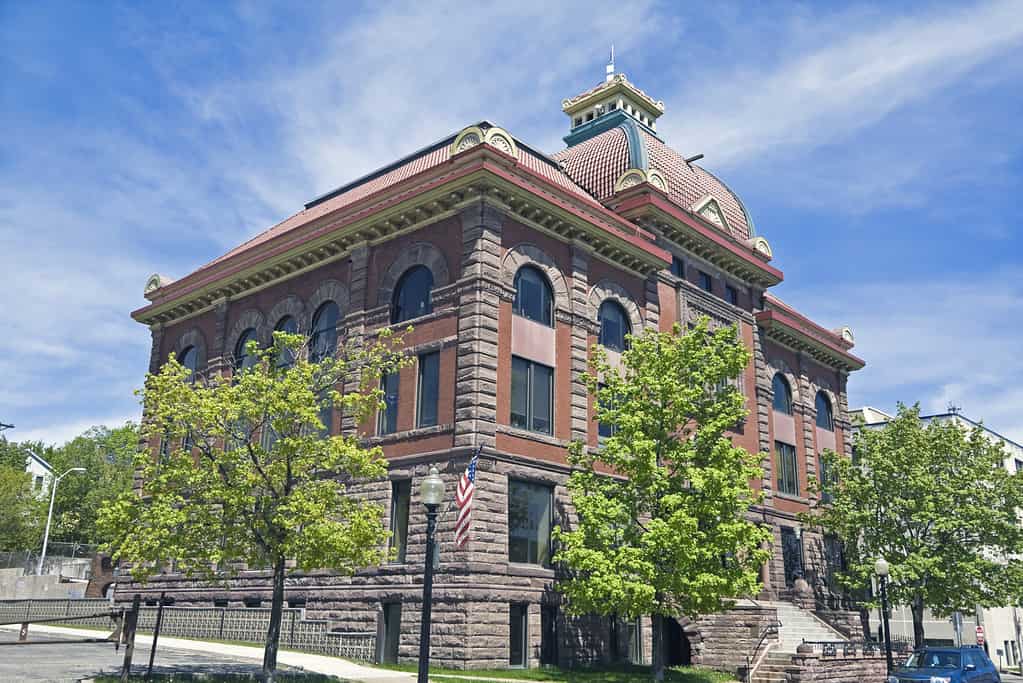
Marquette, Michigan includes several small islands in Lake Superior.
©Henryk Sadura/Shutterstock.com
The city of Marquette was initially known as Worcester because the founder, Amos Harlow, and his expedition leader Pete White came from Worcester, Massachusetts. However, it was renamed after the French explorer Jacque Marquette.
Marquette includes several small islands in Lake Superior:
- Middle Island
- Gull Island
- Lover’s Island
- Presque Isle
- Pt. Rocks
- White Rocks
- Ripley Rock
- Picnic Rock
Alpine skiing is a popular pastime on Marquette Mountain, which is situated in the city. Other landmarks in the city include Marquette Branch Prison and Trowbridge Park, which is located to the west of Marquette.
Additionally, this city is home to the largest wooden dome on the planet, called the Superior Dome. It belongs to Northern Michigan University, whose football team plays home games there. Furthermore, the wooden dome also hosts many public and private events, which draws people in from all over Michigan.
10. Greenville — 1867
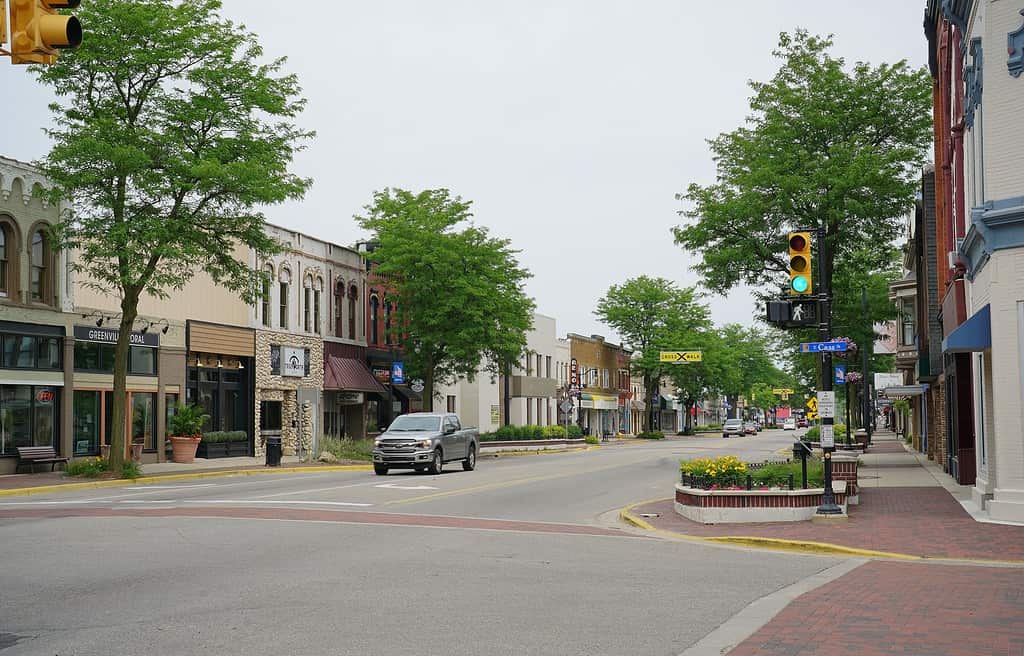
Greenville, Michigan was first home to the Native American Odawa tribe.
©Fsendek/Shutterstock.com
The Native American Odawa tribe was the first resident of Greenville, Michigan. However, in 1844, John Green settled on the land and formed a community.
Therefore, the settlement was initially named Green’s Village after its founder. John also built a sawmill on the river, which created employment and drew in more settlers.
In fact, these settlers were primarily of Danish descent. Greenville established its first post office in 1848, and they were eventually incorporated as a village in 1867. However, only a few years later, in 1871, it was reincorporated as a city.
Summary of the Ten Oldest Cities in Michigan
| Rank | Cities in Michigan |
|---|---|
| 1 | Sault Ste Marie |
| 2 | St. Ignace |
| 3 | Mackinac Island |
| 4 | Detroit |
| 5 | Dearborn |
| 6 | Birmingham |
| 7 | White Pigeon |
| 8 | Traverse City |
| 9 | Marquette |
| 10 | Greenville |
The photo featured at the top of this post is © Alexander Lukatskiy/Shutterstock.com
FAQs (Frequently Asked Questions)
What is the oldest cities in Michigan?
Archaeological evidence shows humans have resided in the Sault Ste Marie area since 2000 B.C. Tribes like the Ojibwe call this place Bahweting, meaning the gathering place. However, a formal settlement was only established in 1668 by several Jesuit priests, including Jacques Marquette, who lived in the area, and St. Jogues, who arrived in Sault Ste Marie in 1641.
What is the 2nd oldest city in Michigan?
- Sault Ste Marie
A formal settlement was only established in 1668 by several Jesuit priests, including Jacques Marquette, who lived in the area, and St. Jogues, who arrived in Sault Ste Marie in 1641.
2. St. Ignace
St. Ignace is the second oldest city in Michigan, as it was established in 1671 by French Jesuit Jacques Marquette.
When was Detroit discovered?
Detroit initially started as a fort for the French. Antoine de la Mothe Cadillac led the construction with 100 workers and soldiers and built this impressive stronghold on the Detriot river in 1701. And in 1760, a small town began to develop. However, the British captured Detriot in 1812, during the Seven Year War. But their reign didn’t last long, and in 1813, the United States Army recaptured the city.
Thank you for reading! Have some feedback for us? Contact the AZ Animals editorial team.






